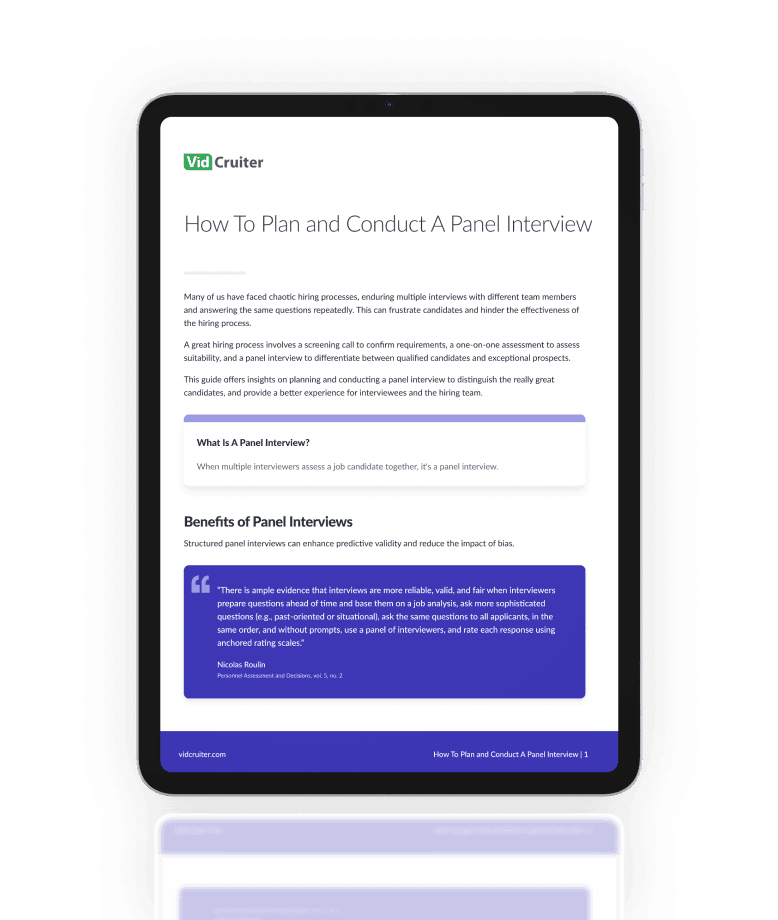
What is an Applicant Tracking System?
Learn how Applicant Tracking Systems streamline recruitment from job posting to offer letter in our guide.

Panel interviews are when two or more people question a single job candidate at the same time. They are one of the most effective ways to evaluate any type of candidate selection criteria. When paired with structured interview methods, panels can introduce diverse perspectives, improve candidate experience, minimize bias, and improve the quality of your hires.
Read on to explore best practices for planning and conducting panel interviews and learn different ways candidates can prepare to be interviewed by a panel.
A panel interview is an interview format that consists of multiple panelists and a single candidate. Each panelist asks the interviewee one or more questions, which typically align with that panelist’s role within the company and where the job candidate’s role will align with their own.
Interview panels typically include anyone whose role or skills are essential in helping the hiring team select the right candidate. The individuals chosen to sit on an interview panel may include potential supervisors, coworkers, subordinates, HR staff, and other decision-makers. Subject matter experts may be included to add additional perspective on the candidate's knowledge or credentials. Panels improve efficiency by bringing people related to the role together to hear the same questions and answers in real-time.
Panel interviews are those that include multiple interviewers and one interviewee, while group interviews consist of multiple job candidates interviewing for a job at the same time (with one or more interviewers). Group interviews are often used to screen a large number of people at one time in a high-volume hiring situation, and are helpful for assessing interpersonal dynamics and other soft skills. Group interviews have only one interviewer, whereas panel interviews allow for multiple evaluation perspectives.
Structured panel interviewing bring together two tested interview tools: structured interview methodology, as outlined by the Office of Personnel Management, and the interviewer panel.
What are one-on-one interviews used for?
One-on-one interviews are a valuable component of the hiring process and are particularly effective for:

The main difference between structured and unstructured interviews is standardization. Structured interviews follow a consistent process, whereas unstructured interviews are dynamic and spontaneous.
In unstructured interviews, the questions may vary among the interviewees. They are flexible by nature and rely on spontaneity during the interview. The evaluation after the interview is also much more informal — think jot notes.
Structured interviews typically follow an interview guide that is based on a job analysis. The interview guide includes the questions and probing questions to ask, the evaluation framework, the number of interviews, the sequence of interviews, who the interview panelists are, the length of the interview, and what assessments or skills tests will be required. Everything should be documented for compliance.
While structured interviews may seem like a lot of work, the familiar professional structure improves candidate experience, minimizes bias, and results in choosing the most qualified candidate for the job.
Most hiring processes in North America, according to Interview Genie, lie somewhere in the spectrum between fully structured and unstructured but tend to favor an unstructured, informal format.
To improve your organization’s hiring efficiency, adding structured panel interviews to your strategy is a great place to start.
Structured panel interviews offer many advantages — but don’t take our word for it — a 2019 Bowling Green State University report on structured interviews summarizes the benefits well:
“There is ample evidence that interviews are more reliable, valid, and fair when interviewers prepare questions ahead of time and base them on a job analysis, ask more sophisticated questions (e.g., past-oriented or situational), ask the same questions to all applicants, in the same order, and without prompts, use a panel of interviewers, and rate each response using anchored rating scales.”
Nicolas Roulin
Personnel Assessment and Decisions, vol. 5, no. 2
The human mind often makes shortcuts for quicker decision-making. In recruiting, this can often lead decisions to be impacted by hiring biases. Although these biases cannot be entirely eliminated, awareness and corrective measures can mitigate their effects in scenarios like hiring.
Structured panel interviewing is particularly effective because it dilutes the influence of individual biases. As highlighted by Harvard Business Review, solo interviews are more susceptible to such biases affecting both the questions posed and the interpretations of responses. Panels, especially with a diverse group of interviewers, significantly reduce these risks by providing a more balanced evaluation, ensuring that personal characteristics like age, gender, race, or religion are less likely to influence the outcome unfairly.
Research conducted by McGill University shows that structured interviews improve accuracy and objectivity, making them a strong indicator of successful job performance. Structured interviews have the highest predictive validity, according to the Journal of Applied Psychology, when compared to other tested interview tools like work sample tests or empirical biodata.
Structured panel interviews ensure uniformity across the process, minimizing variability to just the candidates' responses. Each panelist asks the same questions in the same order, using consistent follow-ups and timing for each interview. This consistency ensures fairness, allowing every candidate an equal opportunity to express themselves and be evaluated solely on their responses.
The use of diverse panel members enhances the quality of questioning, as each brings unique experiences and insights, leading to a more thorough assessment. Diversity in this aspect doesn’t just related to gender and ethnicity, diversity in terms of education, experience-level, skills, knowledge and abilities…etc. This structured approach not only improves fairness but also enriches the decision-making process by incorporating varied perspectives.

Developing processes for panel interviews, then consistently applying them, creates a standardized approach to hiring that has multiple dividends. It ensures that people come into the organization with similar hiring processes. It also allows for employees, over time, to become familiar with the hiring process and develop discipline and consistency in their approach, whether they are leading a panel or a member.
The structured interview process is designed to help hiring teams and managers make better decisions about candidates.
By using an interview guide, interviewers reduce guesswork, focusing only on the candidate's responses. This standardization fosters familiarity and streamlines the process. Once familiar, panel interviewers can refine their questions to better identify strong candidates. Additionally, having all panelists present to hear the same responses simultaneously allows for more comprehensive data collection and ratings than in one-on-one interviews.
A single panel interview can replace multiple one-on-one interview steps, saving the candidate time and trips to your workplace (or virtual sessions).
Panel interviews allow candidates to see the dynamics between some of their coworkers and organizational leaders and gauge reactions from multiple perspectives.
A panel interview is very different from day-to-day work within an organization. However, it is still an excellent way to gain insights into how candidates hold themselves in a group setting.
Roles often require the ability to communicate and work as a team. Employees must interact with colleagues across titles, positions, and power dynamics. These interviews can show how well a candidate performs in such scenarios and provide a better sense of how they work in groups and read the room.
Structured panel interviews, particularly digital ones, help ensure interview compliance and reduce the risk of legal issues and discrimination complaints. By securely maintaining detailed records of interviews, you provide evidence of a fair hiring process. These records can support hiring managers’ decisions in the event of a dispute or a grievance. Additionally, even in unstructured panels, the presence of multiple interviewers can lower the risk of individual allegations compared to one-on-one interviews.

A 2002 article in Public Personnel Management said, “after over 50 years of research, the panel interview remains an important yet controversial tool for personnel selection.” Like any interview method, along with the pros, there are some cons. Awareness of common pitfalls and how to address them head-on is key to minimizing the potential downsides of conducting great interviews.
Imagine sitting by yourself with two to eight people observing you from across a table. Even just imagining it is enough to give some people sweaty palms. Interviews, in general, are stressful for applicants. Being empathetic and considerate of the interviewee's feelings, especially if you’re hiring for an entry-level position, is crucial.
Do not turn the interview into a stress test for the candidate. If you want to see how they handle pressure, interviews are rarely the most accurate way to assess how they’d use their skills in a stressful job-specific situation.
Tips to make the interview less stressful for the applicant:
Some say these interviews don’t work because they can lead to groupthink and other forms of bias rather than introducing multiple perspectives. While this can be true, you can take action to stop this from happening.
Limit sidebar conversations
Ask panelists to withhold from chatting about feedback during the interview. If you are doing a virtual interview, apps like Slack or Microsoft Teams chat should be closed during the interview so you can stay focused on the task at hand. It can be distracting for the panelists and potentially the candidates if they can tell you are preoccupied.
Have each panelist evaluate the candidate individually
Ask each interviewer to rate the candidate's answer before moving on to the next question. If you use rating software, set your system so panelists have to submit their assessments before closing the video interview window.
Panel interviews require more than switching between team members who are working from the same set of questions. That approach offers very little value to the company, as it could easily be accomplished one-on-one. Keeping in mind that panel interviews increase the level of stress on candidates, you will want to ensure that you’ve created a replicable format that can be easily adapted for each interview conducted using a panel.
An effective process starts with effective planning. The hiring manager, often in partnership with an HR staff member, is responsible for defining the parameters of the position being hired for. Once the structure for the interview has been identified, the next step is planning the interview guide.
The interview guide provides key position knowledge, their roles, the interview format, the panel interview questions, the interview logistics, and more. Putting in the work to create a structured interview process (that includes a panel interview) will give you the best chances of hiring once and hiring well.
Competencies are the “how” of a job
According to the U.S. Office of Personnel Management, competencies are "a measurable pattern of knowledge skills, abilities, behaviors, and other characteristics that an individual needs to perform work roles."
Search the type of job you're looking to hire for in the O*NET OnLine database to find examples of core competencies for specific roles.

The interview format sets the tone and drives outcomes for the entire process.
Based on the job analysis, you need to determine:
Structured panel interviews are useful and relevant for the majority of interview processes, but some stages may be best served by other formats, like screening interviews or skills assessments. With a clearly defined process, you can ensure that panelists and candidates understand what is happening, when, and why.
A critical task is determining how many people and who serves on the interview panel. Diversity – in all forms – is essential. In some cases, corporate policies may indicate who should be present for specific panels. The interview guide can also add specific criteria to interview panel members. All of this should be considered to compose diverse interview panels.
Consider the following factors when putting together your panel:
|
|
In addition, consider the roles individuals will take on in the interview panel. Usually, the direct supervisor, or a designee, leads. You could also include others who will engage with the successful candidate as peers or direct reports.
When selecting panelists, determine if they are willing, able to follow instructions, available, mindful, and reliable. If panelists don’t want to be there or don’t show up, that’s not beneficial for your process or the candidate.
In a panel, typical roles include:
This is the hiring manager or their designee. They are responsible for greeting candidates, explaining the structure, and ensuring that the candidate is clear on expectations and the process.
Some panels use an experienced and trained facilitator in the structured panel process. The facilitator may not be the most senior person on the panel. They are there to ensure a good flow to the interview, and that no panel member dominates the conversation.
This role is crucial to ensure that all candidates get treated equitably and that the panel complies with guidelines and legal obligations throughout the process. The monitor may play a role in panel training, explaining what to ask and how to respond to specific question types.
The records keeper ensures that all records from the interview (but not the evaluations) are managed, maintained, collected, stored, and coordinated. These records may include resumes, job applications, interview schedules, and panel meeting agendas.
Many panels have members with a particular expertise or niche role in the organization that is salient to the position. These members bring their perspectives and insights to the questions and candidate answers.

Once you've made the list of competencies, you can work on developing your questions. In panel interviews, you want people with multiple points of view asking questions related to the core competencies identified in the interview guide. The purpose of panel interviews, generally speaking, is to find candidates who the panel could realistically work with. The best way to achieve this is to find the right panelist to ask the right questions.
There are several types of panel interview questions to consider.
Competency-based interview questions aim to evaluate candidates' strengths and weaknesses and see how they pair up with the critical competencies required for the role.
Competency-based questions are good to ask in panel interviews because they allow the panel to identify early on if candidates have leadership potential or demonstrate values that align with your company values. They are also effective at evaluating traits like teamwork, decision-making, and communication.
Sample questions include:
Behavioral-based interview questions focus on past experiences and situations. It’s important to ask behavioral-based questions in panel interviews because they can be a good way to assess how candidates hold themselves in a professional environment, handle difficult interpersonal situations, and respond to stress.
Here are some sample behavioral-based questions:
Situational interview questions explore how candidates will react to situations they may face in the future. These questions are as close to a job simulation as you can get, so it would be good for the subject matter expert on the panel to ask this. Be prepared for the candidate to have clarifying questions so they can provide a more accurate hypothetical answer.
Here are some situational question examples:
To develop an effective panel interview process, you must create a logical sequence for asking questions.
Here is a sample sequence to consider:
For too long, search committees have been asked which candidates they "liked best" or "were good fits for the job." Those processes invite the influence of bias and do not allow for a disciplined evaluation. The following evaluation methods make it easier and more consistent, provide a way to standardize feedback, and ensure the applicant has the knowledge, skills, and competencies you’re looking for.
Here are a few of the best evaluation methods for panels:
On a five-point scale, one might be considered poor, and five considered excellent. For each competency, panelists score the candidate’s answers.
Identify the competency you’re measuring for and provide incremental descriptions of each competency level.
Applies the competency in the most difficult situations and is a resource and advisor for others
Applies the competency in extremely difficult situations with little or no guidance
Applies the competency in the most difficult situations with minimal guidance
Applies the competency in some difficult situations with frequent guidance
Applies the competency in the most basic form but requires extensive guidance
Forced ranking is probably the most controversial evaluation process. It is most commonly used when evaluating candidates in highly competitive situations, like when hiring for C-suite positions or selecting someone to receive a high-value scholarship.
There are a few ways forced ranking can be done in an interview setting. Interview panelists can rank candidates in relative comparison to each other for each question, which forces interviewers to ask themselves, “how was Mary’s answer compared to Navpreet and Patrick’s?” Then, all the comparisons are combined to see who ranked highest for the most answers.
Another option is forced distribution, where an appraisal doesn’t compare people against each other but gives candidates ratings like excellent, good, or needs improvement based on their answers. A set number of applicants must fall into each category, and the person who lands in the excellent category is the frontrunner.
BARSs allow evaluators to grade applicants on past or future behavior. It defines what actions constitute effective and ineffective performance related to a specific situation, which is why BARSs are more accurate (produce less variance between raters) than a straight numerical one-to-five scale, according to an ETS Research Report.
A BARS can be used for almost any role, but it’s often used in industries with high-volume environments where a common service level is generally understood.
By knowing what can lead to success and failure, you can compare how an individual performed in past scenarios or will perform in future work situations against specific examples. From there, interviewers grade the candidate’s answers against well-defined behaviors discovered in the job analysis that have been ranked.
Let’s say you’re hiring for a customer service role, and you’re evaluating how an applicant has, or might, handle a difficult customer. Here’s an example of what that five-point BARS could look like:
Exceeds acceptable levels of performance (outstanding)
Listens to why they are upset. Apologizes and addresses the customer’s pain point. Remains calm regardless of what the person says or does. Continues serving the customer. Only calls the manager over if necessary.
Apologizes. Remains calm unless directly provoked. Continues serving the customer. Only calls the manager over if necessary.
Meets acceptable levels of performance (satisfactory)
Doesn’t show outward expressions of impatience. Continues serving the customer. Only calls the manager over if necessary.
Shows outward expressions of impatience. Does not apologize. Calls manager over to handle the situation.
Fails to meet acceptable levels of performance (unsatisfactory)
Shows several outward expressions of impatience. (sighs, rolls eyes, crosses arms, smirks, or laughs). Does not apologize. Talks back to the customer or takes a hostile tone. Withholds customer service.
A BOS is a behavior-based measure used in situational interviews or job simulations to evaluate performance. The panelist uses one or more scales to evaluate to what degree the applicant demonstrated the desired behaviors.
For example, a panelist would choose from the following options for how frequently an applicant demonstrated a behavior:
Almost always
Often
Sometimes
Rarely
Almost never
Ideally, panelists would conduct their evaluation during the interview. For all evaluation methods, as described in this study by McMaster University, predictive validity is highest if ratings are completed immediately after each question and before starting the next. Keep interviewer scores as independent as possible, and ensure interview panelists submit their scorecards or rating grids immediately after the panel ends.
If your evaluation process is captured on paper or still done in unsecured documents, consider switching to a digital interview platform. Rating software can not only help structure your process, but also it’s the best way to capture and securely store candidate evaluations and remain in compliance. Having a digital record of your process can serve as proof of an equitable process.

Two key aspects of planning an interview are logistics and structure, which ensure consistency and fairness. For in-person interviews, use the same room and seating arrangement for all candidates. For virtual interviews, panelists should use a consistent background and test their video settings to avoid distractions.
It's also important to monitor each panelist's talk time to prevent any one person from dominating the discussion, ensuring the focus remains on the candidate’s responses. Avoid interrupting the candidate unless necessary due to time constraints. Schedule panel interviews at consistent times and days to maintain a routine for panelists and similar conditions for all candidates.
Have contingencies developed for unexpected events, like an unexpected absence by a panel member, a Wi-Fi outage (for digital interviews), a snow day, or a fire alarm during the panel interview. Again, the key is to create consistent interview conditions for each candidate.
If you follow these steps, your interview plan should have:
Preparing the hiring team for the process is vital. Meeting before the start of the interviews to get aligned on the structure, desired outcomes, schedules, roles, and expectations will make the interviews much smoother.
Your pre-interview preparations ensure everyone is on the same page. It will include a discussion about the competencies and the interview format itself. It may include information about the number of candidates and the time commitment involved.
Panelists should then review the following:
Panelists may need training to ensure evaluation consistency, understand how their assessments are monitored, and manage speaking time among themselves. HR staff, experienced hiring managers, or facilitators typically provide this training. The details discussed in pre-interview meetings are often in the interview guide, which may be digital or printed.
Utilize HR technology solutions, especially for hybrid or remote teams, to maintain compliance and enhance your interviewing process. Consider upgrading from general video conferencing tools to a video interview software, which can offer custom workflows and embedded guides for compliance.
Additionally, ensure that each candidate is uniformly prepared for the interview with consistent information about the process, time commitments, and panelist details where possible. This preparation helps standardize the candidate experience.

Things can sometimes go wrong despite the best preparations. Have a plan, so you know how to address these issues in the moment.
Here are a few of the most common interview snafus and how to handle them:
Poorly prepared panelists or candidates
Applicants who haven’t researched the organization and reviewed the role in depth can leave a poor impression. For poorly prepared panelists, this may mean the lead needs to intervene and provide context. For ill-prepared candidates, there may need to be more explanation given about an organization or role.
Time domination
When panelists begin to monologue, it can be difficult to reel them in. It may be best to wait for a break and ask panelists to keep introductions or follow-up remarks to a minimum. You might need to tell overly detailed candidates that there are many questions and that while the details are appreciated, answers do not need to be as comprehensive.
Intimidating candidates
Panelists who opt to throw their weight around or cut the candidate off can be problematic. Sometimes the lead interviewer may need to reassure a candidate they believe has become unnerved to help them regain composure.
Talking badly about past job holders
This line of conversation is never acceptable, but it happens. While it may be awkward to reprimand a colleague during the interview, it may be necessary to remind people to maintain confidentiality and not discuss past or present coworkers.
The most important post-interview task is ensuring all ratings get completed. Evaluations can be done live during the panel interview or scheduled right after the interview ends. Even after the candidate has left, the panelists avoid launching into a conversation about their thoughts or start having sidebar chats on Slack or Teams. Remind panelists to withhold their thoughts until the evaluations are completed, submitted, and tallied.
It’s important to consider a broader evaluation of the process once all interviews conclude. A debrief can help you understand what went well and what could be improved. Such feedback can help fine-tune future interview processes.
Consider having individual conversations with panelists to discuss their involvement and how they can improve.
Panel interviews can create the opportunity for a more objective hiring process. When combined with a structured interview methodology, panel interviews can increase the quality of hires and minimize the impacts of bias.
Panel interviews are a best-practice approach to candidate evaluation. They can offer insight into future success, reduce legal liability and ensure that all participants gain a deeper understanding of candidate experience and competencies.
By using the approaches and practices in this guide, employers can better understand how to build structured panel interviews that result in higher predictive validity and greater efficiency and efficacy.

Downloadable Template
Panel Interview Template and Checklist
Get your free copy of VidCruiter’s Panel Interview Template and Checklist. This practical guide:
By providing email address, you agree to
receive updates from VidCruiter.
Read our
Privacy Policy
In a panel interview, multiple interviewers—often from different seniority levels and job functions—simultaneously question a candidate. This structure enables a diverse assessment of the candidate's skills and fit for the role. Each interviewer introduces themselves and takes turns asking questions, providing a comprehensive evaluation from various perspectives.
Recruiting organizations should develop a structured interview process, which includes deciding on the panel's composition, preparing consistent interview questions based on the releant job competencies, and training panelists to ensure unbiased and fair evaluation. Complete documentation of the process is essential for compliance and effective process assessment.
In a panel interview, introduce yourself by stating your name, role, and a brief connection to the position. Your goal should be to inform the candidate about who you are and establish your credibility and relevance to this interview. Keep your introduction short to maintain focus on the candidate.
Modernize your hiring process with expert insights and advice.